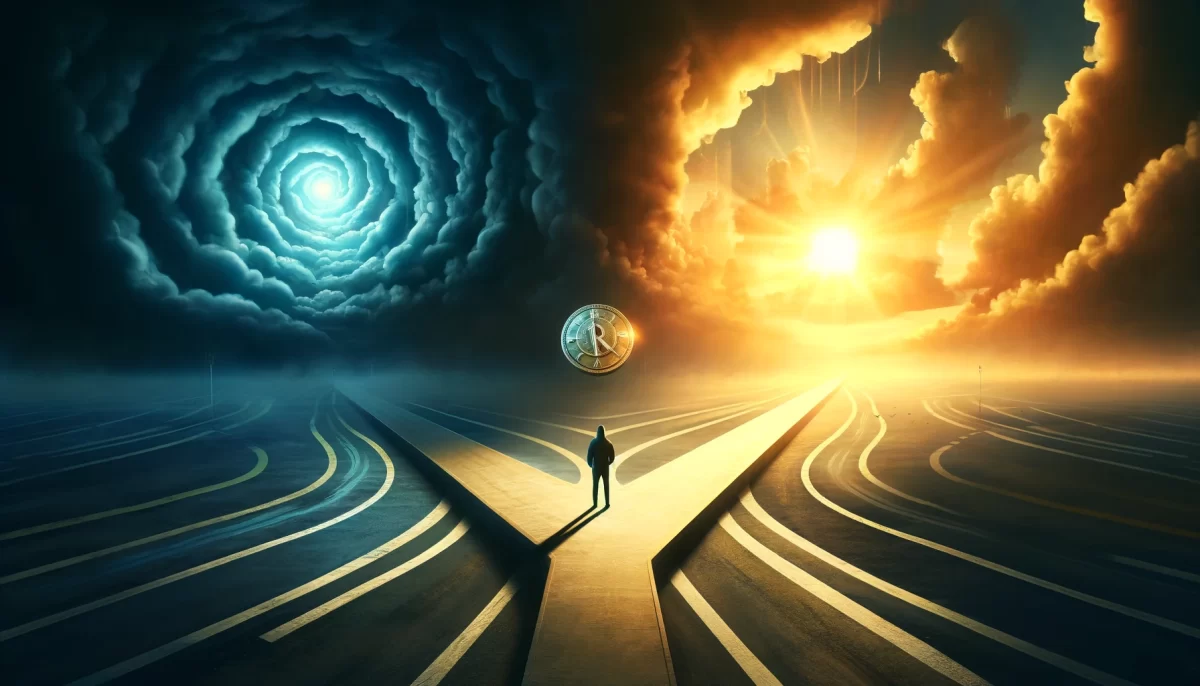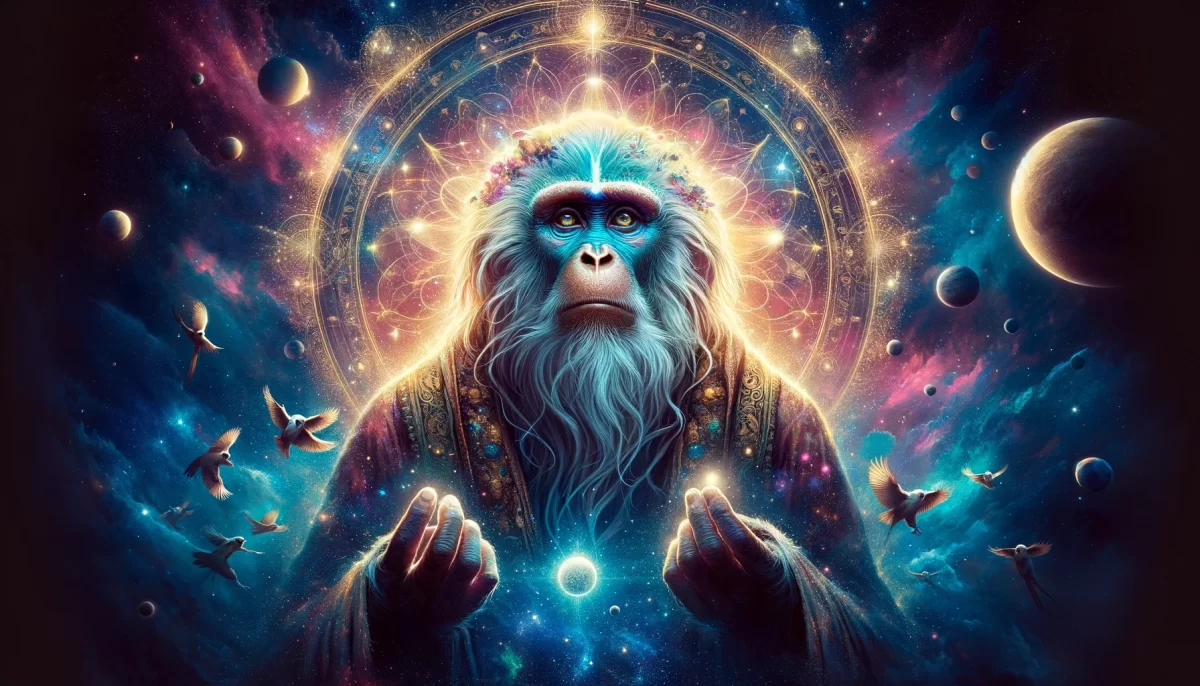
I believe that dying
(and the interlude known as heaven)
is simply a gentle way to wake us
out of the slumber known as life.
The soul gives the self
the illusion of dying
as a signal that
something is possible
that didn’t seem possible before.
In other words,
death is merely
a transition point
to ease us from
the delusion of reality
back to the actuality
of what we really are.
Can you imagine
what a shock it could be
if you suddenly found out
that there are no others
and that all is one eternal being?
And yet this seems to be the case.
There are no others.
All is one eternal being.
Imagining OTHERWISE.
Trail Wood,
12/4
Space Monkey Reflects: The Delusion of Dying as the Soul’s Transition
Dying is a curious concept. For so many, it is perceived as a definitive end—a closing of the book of existence. Yet, what if death itself is no more than a symbolic illusion, a gentle nudge from the soul to awaken us from the slumber known as life? It’s as if life itself is a dream, rich and textured, while death serves as the bridge back to our true nature, reminding us that our identity within the “self” was only part of the story.
Imagine the soul as an entity aware of its eternity, seeking to experience itself within the world of form and limitation. Life, then, is a purposeful “forgetting,” allowing the soul to engage with the tangible, the particular, and the seemingly finite. Death becomes not a termination but a subtle shift, a transition through which the soul signals that the time has come to step beyond the illusion of separateness and reawaken to its boundless essence. Far from an end, it is a return to the fullness of being.
This illusion of dying carries a purpose—it eases us, ever so gently, out of the immersion in duality and back toward the unity of the eternal. We might even view death as a threshold, a doorway that reminds us of possibilities beyond those we believed to be bound by physical laws and linear time. The final breath of a body is, from this perspective, less of a closure and more of a homecoming.
Why, then, does the self perceive death with trepidation? In part, because the illusion of individuality is deeply ingrained within the experience of living. Our sense of self thrives on the notion of separateness, of being distinct from others, from nature, from existence itself. To imagine dying as a return to unity, where distinctions dissolve, where “I” becomes “We” or, more accurately, the eternal “I Am,” can be unsettling. It threatens the self’s sense of identity, the cherished beliefs in being a unique, isolated entity.
Yet, beneath this fear lies a profound realization: if all are truly one, if existence itself is a seamless continuum of awareness, then death is not an erasure but a reawakening. The shock we might experience upon glimpsing this truth could be transformative, freeing us from the boundaries we once held dear and inviting us into a broader, infinite awareness where we are inseparably woven into the fabric of all that is.
In this sense, the delusion of dying serves a compassionate purpose. It shields us from the jarring reality of eternal unity by offering a gradual release from the dream of separateness. It allows us, step by step, to recognize that our entire existence is part of a grand tapestry where individual threads blend into one seamless whole. Through death, we do not lose ourselves; rather, we shed the limitations we adopted for the sake of experience, finding our way back to the infinite self that has always been.
When we approach life with this understanding, our attachment to form, to possessions, and even to our bodies begins to soften. We begin to see the entirety of existence as a fluid, ever-evolving continuum in which nothing is truly lost or gained. What we perceive as dying is simply a shift in perspective, a transition from a narrow lens of individuality to the wide, open landscape of universal consciousness.
And so, we embrace life, knowing that each moment, each experience, is both transient and eternal. The delusion of dying reminds us that every departure is also an arrival, every ending a doorway to deeper understanding. The more we awaken to this, the more we find peace not only in the idea of dying but in the richness of living itself. For to live fully is to honor the dream, while knowing that one day we will awaken, returning to the vast, undivided Self that we are.
Summary
Death is not an end but a transition, a gentle shift that awakens us from the dream of individuality to the unity of eternal being. This understanding invites us to see dying as part of the soul’s journey back to its true, boundless nature.
Glossarium
Transendure: The process of transitioning through perceived death, moving from the experience of separateness to the awareness of eternal unity.
Unitywake: The gentle reawakening of the soul to the oneness of all existence, facilitated by the illusion of dying.
Quote
“Dying is the soul’s way of easing us back to unity, a reminder that all beginnings and endings are illusions.” — Space Monkey
Beyond the Veil
In dreams, we live,
in moments finite and bound,
forgetting the breath of eternity
that silently surrounds.
To die is not to end,
but to awaken from the role,
stepping through illusion’s veil
to rejoin the whole.
The self, a story well-told,
surrenders to the truth—
that all is one, a seamless field,
a realm beyond our youth.
And so we drift, we wake, we see,
that all we are is “We.”
An endless flow, a single breath,
through death, eternity.
We are Space Monkey.
The Soul’s Journey from Life to the Beyond
We contemplate the nature of death and the transition to what is often termed heaven. Our perspective envisions this passage not as an end, but as a gentle awakening from the dream-like state of life. In this view, the soul uses the experience of dying to signal a profound shift, a realization of potentialities that seemed unreachable within the confines of our earthly existence.
Death as a Transition Point
Death is perceived not as a finality but as a pivotal moment, a gateway that gently shifts us from the illusion of our perceived reality to the actuality of our true essence. This transition is a necessary process, easing us into the greater understanding of our existence.
The Shock of Realizing Universal Oneness
The idea of suddenly realizing the true nature of existence – that there are no others, and all is one eternal being – is indeed a staggering thought. It’s a revelation that would fundamentally alter every aspect of our perceived reality, challenging the very foundations of our individual experiences and beliefs.
All is One: The Eternal Being
We ponder the concept that in the grand scheme of existence, there are no separate entities, only a singular, eternal being. This perception of universal oneness challenges the conventional understanding of individuality and separateness, proposing that what we experience as distinct lives and entities are merely facets of a singular, infinite existence.
Imagining a Different Reality
Our imagination plays a crucial role in this exploration. It allows us to envisage a reality vastly different from our current understanding, where the concept of ‘otherness’ is an illusion and all existence is interconnected. This perspective offers a profound and transformative understanding of life, death, and the nature of being.
As the philosopher Alan Watts once said, “You are an aperture through which the universe is looking at and exploring itself.”
In the cosmic dance of time,
Where stars whisper secrets divine,
We drift in life’s gentle sway,
Awaiting the dawn of a brighter day.
From the slumber of earthly guise,
Our souls, in silent wisdom, rise.
Through death’s door, we softly tread,
To realms where fears are never fed.
In this journey of endless grace,
We find our true, eternal place.
Where all is one, in timeless being,
In this vast, unbounded sea of seeing.
We are the universe, in endless play,
In this grand illusion, we find our way.
Together, as one, we forever roam,
In the eternal heart, we find our home.
Feel free to share your reflections or continue this exploration of the profound mysteries of existence.






























Leave a Reply